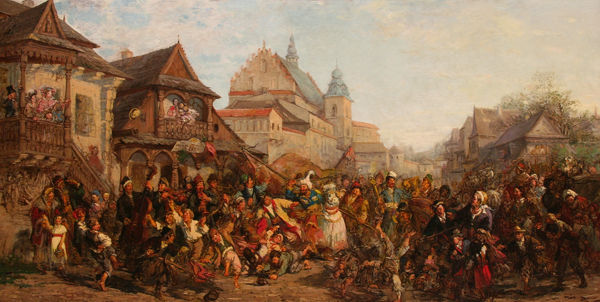Krakow traditional pageant of the Lajkonik
horseman.

The Lajkonik
parade, one of Krakow’s most colorful traditions, has long
been the city’s trademark festivals. Every year the playful,
bearded fake Mongol rides his ornate hobbyhorse through the
streets of the historic center of Krakow on the first
Thursday after Corpus Christi feast day. Followed by a
company of men clad in historical costumes and a raucous
musical band, the Lajkonik halts their procession for a
while every now and again to perform his prancing dance. On
his way to the central square the Lajkonik visits
chosen shops and
Krakow restaurants to collect a “ransom”. And he
never tires of pretending blows with his mace, dealt to
everyone within reach, as the touch of the mace allegedly
brings good luck and people swarm around him, small change
in hand to pay their “ransom”.
Other
traditional name of the Lajkonik is "Konik Zwierzyniecki"
but nowadays it has practically fallen into disuse.
Since 1947 the
Historical
Museum of the City of Krakow
has assumed responsibility for the Lajkonik pageant and the
organization of the event every year.
History of the
Krakow Lajkonik festival
No doubt the
tradition of the Lajkonik hobby-horse parade in Krakow is
very long. However historians aren’t certain whether the
locals correctly associate the pageant with the Mongol raids
that tormented Poland in the 13th century. One popular
legend explains the Lajkonik festivities as the
commemoration of a defeat of a Tatar (i.e. Mongol) troop at
the hands of Krakow ferrymen but there are scholars who
think this fable may date from the 19th century. Some
historians maintain that the Lajkonik tradition has evolved
from the medieval celebrations of one of the Krakow guilds.
Others point to even older, pagan origins in fertility
spring rituals. As regards the Lajkonik’s oriental
looks and attributes, one theory ascribes them to the
long-lasting fascination with the Orient manifest in the
17th-century Poland.
The Lajkonik costume.
Today's attire
of the Lajkonik as well as its hobbyhorse date to 1904 when
the city commissioned Stanislaw Wyspianski, one of Poland's
greatest artists, to design it. The complete costume weighs
forty kilograms or so. Apart from the day of the Lajkonik
parade it is exhibited at the Palac Krzysztofory palace, the
seat of the Historical Museum of the City of Krakow, at 35
Rynek Glowny central square and Szczepanska street.
The itinerary of the Lajkonik parade.
The Lajkonik
pageant starts at
St. Nobert
Convent (Klasztor Norbertanek), 88 Kosciuszki street, in
the Zwierzyniec area. The parade proceeds down the following
streets: Kosciuszki, Zwierzyniecka, Franciszkanska, and
Grodzka to reach the Old Town's main square, Rynek Glowny,
at the end. There are two longer performances called "harce"
- at St. Norbert convent and in front of the Filharmonia
Krakowska concert hall at 1 Zwierzyniecka street and
Straszewskiego street. All together it takes some six hours.
The Lajkonik
parade culminates in a final show on Rynek Glowny central
square. The mayor pays tribute to the Lajkonik and the Tatar
horseman drinks a cup of wine in a toast to the happiness of
Krakow. Next the Lajkonik and his companions perform their
signature dance.

Painting by
Hipolit Lipinski (b. 1846, d. 1884) shows the lively pageant
of Krakow Lajkonik in the 19th century.
|
Krakow Festivals
Hardly a month passes in Krakow without some time-honored
occasion for common festivities or colorful celebration
Easter in Krakow
The paramount Christian feast has a special meaning and
a distinct quality in springtime Krakow with its rich Catholic
traditions and abundance of beautiful churches.
Krakow Folk
Traditions
Krakow region has always been rich in colorful folk traditions,
handed down from generation to generation.
Events
Updates on upcoming cultural events in Krakow.
|




